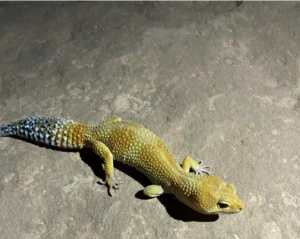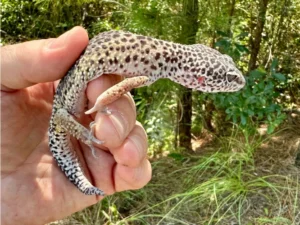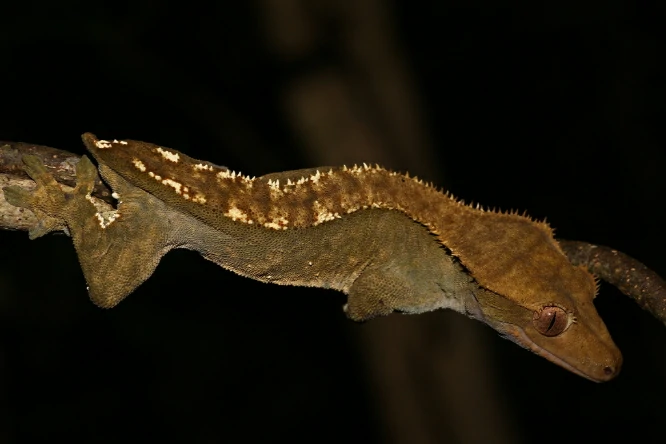If you’ve had your gecko for a while, you probably know its eating habits pretty well. Maybe it zooms for every cricket you drop in, or maybe it’s the slow, careful type that waits for the perfect moment to strike.
But one day, you notice something strange. The gecko that usually eats like a tiny vacuum cleaner suddenly doesn’t care about food at all. It just sits there, looking kind of dull and not moving much.
You might be seeing the start of a shed. So, does that mean geckos stop eating when they’re shedding?
Yes, most geckos lose their appetite and eat less, or stop eating completely for a short time while they’re shedding. It’s completely normal. Shedding is stressful for them, both physically and mentally. Their bodies are busy getting rid of the old skin, and that takes a lot of energy. Because of that, eating often slows down or stops for a few days.
Why Shedding Affects Their Appetite
When a gecko is about to shed, a few things happen inside its body. Its skin loosens, a thin layer of fluid builds up between the old and new skin, and the outer layer starts to look dull, cloudy, or grayish.
During this stage, your gecko’s body is doing something similar to what happens in mammals after a scrape, but on a bigger scale.

It’s not painful, but it can be uncomfortable. Their vision can blur, their skin feels tighter, and they’re more sensitive to touch.
So when your gecko’s body is busy with all that, eating just isn’t a top priority. Think of it like how you might not want a big meal when you have a cold.
It’s not that you can’t eat, your body is just focused on something else.
What You’ll Notice Before Shedding Starts
You’ll usually see a few signs before a shed, like:
-
Dull or cloudy skin: Your gecko’s colors might fade or look dry.
-
Cloudy eyes: Especially for leopard geckos, their eyes might look grayish or milky.
-
Restlessness or hiding: Some geckos hide more, others get more active. It depends on the species.
-
Less appetite: They may ignore food for a few days before the shed starts.
If you notice these signs, don’t panic if your gecko refuses food. It’s just getting ready.
Geckos Might Even Eat Their Own Shed
Here’s something that surprises a lot of people: geckos often eat their shed skin.
It might sound strange, but it’s actually really smart. The old skin still has nutrients like keratin and protein. By eating it, the gecko recycles some of what it used to grow that skin in the first place.
There’s another reason too: it helps them stay hidden from predators. In the wild, leaving bits of old skin around is like leaving a big “I was here” sign. Eating it keeps them safe.
This is also why geckos might skip meals before shedding, they’re basically waiting to eat that.
How Long Do Geckos Stop Eating For?
Usually, it’s not long. Most geckos stop eating a day or two before shedding and might skip a day or two afterward. So, about 2–5 days of reduced appetite is perfectly normal.

Once they finish shedding, their appetite usually comes back strong. You might even see them eating more than usual to make up for the missed meals and the energy spent shedding.
If your gecko still won’t eat after a week or more, though, something else could be going on; stress, illness, or tank conditions that aren’t right.
Shedding Isn’t the Same for Every Gecko
Not all geckos handle shedding the same way. Some barely change and eat normally, while others act like shedding is a full-time job.
Here’s how it often looks in common species:
-
Leopard Geckos: Stop eating 1–3 days before shedding. Skin turns pale and eyes cloud up. Usually eat again right after shedding.
-
Crested Geckos: Can get restless, hide a lot, and skip food for several days.
-
Tokay Geckos: Might get cranky and hide more, but don’t always skip meals completely.
-
House Geckos: Tend to eat less and hide more until the old skin is gone.
So, it really depends on the species and even the individual gecko.
How You Can Help During Shedding
While your gecko is shedding, there are a few simple things you can do to make it easier, and maybe help it start eating again sooner.
Keep the Humidity Just Right
- Dry air makes shedding harder. If the enclosure is too dry, parts of the old skin can get stuck, especially around toes and tail.
-
Mist the enclosure lightly once or twice a day.
-
Add a humid hide, a small box or cave with damp moss or paper towel inside.
A humid hide gives your gecko a moist place to loosen the old skin and stay comfortable.
Don’t Force Feed
- If your gecko refuses food, don’t try to make it eat. That only stresses it more. Leave food available, and it’ll eat when ready.
Make Sure It Can Shed Comfortably
- Give rough surfaces like rocks, bark, or textured hides. That helps your gecko pull off old skin naturally.
Don’t Peel the Skin Yourself
- Even if it looks stuck, never pull it off. You can gently help by soaking your gecko in lukewarm water for 10–15 minutes or letting it walk on a damp paper towel. But don’t tug, that can tear the new skin and cause infections.
When You Should Worry
A gecko not eating for a few days while shedding is normal. But check for problems if:
-
It still won’t eat after 7–10 days
-
It looks thin or weak
-
There’s stuck shed around toes, tail, or eyes
-
It’s lethargic or hiding all the time
If that happens, check the basics:
-
Is the temperature warm enough?
-
Is the humidity right?
-
Is it stressed by handling or a new environment?
If everything looks good but it still won’t eat, it might be time to see a reptile vet. Sometimes infections, parasites, or impaction can make a gecko stop eating, and those need treatment.
Shedding and Young Geckos
Younger geckos shed more often (sometimes every week or two) because they grow fast. That means they’ll skip meals more frequently than adults.
As long as they’re gaining weight and look healthy, it’s nothing to worry about. Adults might only shed once every month or two, depending on the species.
What To Feed After Shedding
Once your gecko finishes shedding and starts eating again, offer its favorite food first, something it really can’t resist.
-
Leopard Geckos: Crickets or mealworms dusted with calcium powder.
-
Crested Geckos: Fresh fruit mix or commercial gecko diet.
-
House Geckos: Small crickets or roaches.

Make sure the food is the right size and gut-loaded (fed nutritious food beforehand). That helps your gecko recover faster.
Common Mistake: Thinking Something’s Wrong
A lot of new gecko owners panic when their pet stops eating. It’s understandable, sudden food refusal usually signals a problem in most animals.
But for geckos, it’s part of a normal cycle. The key is knowing when it’s just shedding and when it’s an actual problem.
A simple rule:
-
If the skin looks dull or faded, it’s probably about to shed.
-
If it still won’t eat after a week and looks thin or sluggish, check deeper.
Why Shedding Is So Important
Shedding isn’t just about looks, it keeps geckos healthy. Old skin can hold bacteria, parasites, and dirt. Getting rid of it prevents infections and allows new growth underneath.
It’s also how injuries heal and colors brighten. Some geckos look much cleaner or more colorful after shedding.
So while your gecko might seem grumpy and uninterested in food, it’s really just doing maintenance.
What About Geckos In The Wild?
Wild geckos lose their appetite too, but they don’t have anyone to mist their enclosure.
Instead, they hide in humid spots (under leaves, inside logs, or in burrows) until shedding is done.
This instinct is built in. Even in captivity, pet geckos follow the same rhythm. That’s why they often disappear into hides before a shed.
Frequently Asked Questions
Do geckos stop eating when they shed?
Yes, many geckos slow down or stop eating when they’re shedding.
Shedding takes a lot of energy, and their skin can feel tight or itchy, which makes eating less appealing. Some might refuse food entirely for a few days, while others nibble only a little until the process is finished.
Once the old skin comes off, their appetite usually bounces back quickly.
Why do geckos stop eating when they shed?
Geckos stop eating when they shed because their bodies are focused on growing and loosening old skin.
Shedding takes a lot of energy, and the tight, itchy skin can make it uncomfortable or even painful to eat. During this time, their digestive system slows down, so most geckos naturally lose interest in food until the new skin is fully in place.
How long do geckos usually go without eating while shedding?
Geckos usually go without eating for a few days while shedding, though it can sometimes last up to a week.
The exact length depends on the species, age, and health of the gecko. Younger or more active geckos might skip food for just a day or two, while older or stressed gecko
Is it normal for a gecko to refuse food during shedding?
Yes, it’s completely normal for a gecko to refuse food while shedding.
Shedding can make their skin tight and itchy, and their bodies focus energy on replacing old skin rather than digesting food. Most geckos will skip meals for a few days, sometimes up to a week, and then return to eating once the process is done.
Do all geckos lose their appetite when they shed?
No, not all geckos lose their appetite when they shed. Many do slow down or refuse food, but some geckos will continue eating normally even while shedding.
Appetite changes can depend on the species, individual temperament, and how stressful or uncomfortable the shedding process feels for them.
Why does shedding make geckos irritable or less active?
Shedding makes geckos irritable or less active because it’s uncomfortable and takes a lot of energy.
Their old skin can feel tight, itchy, or even slightly painful, which makes them want to move less and avoid handling.
At the same time, their body is using energy to grow and loosen new skin, so they naturally slow down and become a bit grumpy until the process is finished.
Conclusion
Do geckos lose their appetite when shedding?
Yes, they usually do, and it’s completely normal and temporary.
Shedding takes a lot of energy, so most geckos just don’t feel like eating for a few days. Once it’s done, they bounce back fast, often with extra enthusiasm.
The best thing you can do is keep humidity right, make sure your gecko feels safe, and let it do its thing.
Shedding might make your gecko seem distant or lazy for a short while, but it’s just their way of hitting the refresh button.
And once it’s done, you’ll see bright new skin, and a hungry little lizard ready to get back to normal life.
Hi, my name is Ezra Mushala, i have been interested animals all my life. I am the main author and editor here at snakeinformer.com.

